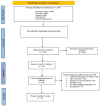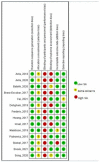Effectiveness of Home-Based Cardiac Rehabilitation, Using Wearable Sensors, as a Multicomponent, Cutting-Edge Intervention: A Systematic Review and Meta-Analysis
- PMID: 35807055
- PMCID: PMC9267864
- DOI: 10.3390/jcm11133772
Effectiveness of Home-Based Cardiac Rehabilitation, Using Wearable Sensors, as a Multicomponent, Cutting-Edge Intervention: A Systematic Review and Meta-Analysis
Abstract
Exercise-based cardiac rehabilitation is a highly recommended intervention towards the advancement of the cardiovascular disease (CVD) patients' health profile; though with low participation rates. Although home-based cardiac rehabilitation (HBCR) with the use of wearable sensors is proposed as a feasible alternative rehabilitation model, further investigation is needed. This systematic review and meta-analysis aimed to evaluate the effectiveness of wearable sensors-assisted HBCR in improving the CVD patients' cardiorespiratory fitness (CRF) and health profile. PubMed, Scopus, Cinahl, Cochrane Library, and PsycINFO were searched from 2010 to January 2022, using relevant keywords. A total of 14 randomized controlled trials, written in English, comparing wearable sensors-assisted HBCR to center-based cardiac rehabilitation (CBCR) or usual care (UC), were included. Wearable sensors-assisted HBCR significantly improved CRF when compared to CBCR (Hedges' g = 0.22, 95% CI 0.06, 0.39; I2 = 0%; p = 0.01), whilst comparison of HBCR to UC revealed a nonsignificant effect (Hedges' g = 0.87, 95% CI -0.87, 1.85; I2 = 96.41%; p = 0.08). Effects on physical activity, quality of life, depression levels, modification of cardiovascular risk factors/laboratory parameters, and adherence were synthesized narratively. No significant differences were noted. Technology tools are growing fast in the cardiac rehabilitation era and promote exercise-based interventions into a more home-based setting. Wearable-assisted HBCR presents the potential to act as an adjunct or an alternative to CBCR.
Keywords: accelerometer; cardiorespiratory fitness; cardiovascular disease; home-based cardiac rehabilitation; physical activity; wearable sensors.
Conflict of interest statement
The authors declare no conflict of interest.
Figures





References
-
- Benjamin E.J., Muntner P., Alonso A., Bittencourt M.S., Callaway C.W., Carson A.P., Chamberlain A.M., Chang A.R., Cheng S., Das S.R., et al. Heart Disease and Stroke Statistics-2019 Update: A Report From the American Heart Association. Circulation. 2019;139:e56–e528. doi: 10.1161/CIR.0000000000000659. - DOI - PubMed
-
- Visseren F.L.J., Mach F., Smulders Y.M., Carballo D., Koskinas K.C., Bäck M., Benetos A., Biffi A., Boavida J.-M., Capodanno D., et al. 2021 ESC Guidelines on cardiovascular disease prevention in clinical practice: Developed by the Task Force for cardiovascular disease prevention in clinical practice with representatives of the European Society of Cardiology and 12 medical societies With the special contribution of the European Association of Preventive Cardiology (EAPC) Eur. Heart J. 2021;42:3227–3337. doi: 10.1093/eurheartj/ehab484. - DOI - PubMed
-
- Piepoli M.F. Cardiac rehabilitation: What are the latest advances? Dialogues Cardiovasc. Med. 2017;23:33–38.
Publication types
Grants and funding
LinkOut - more resources
Full Text Sources

